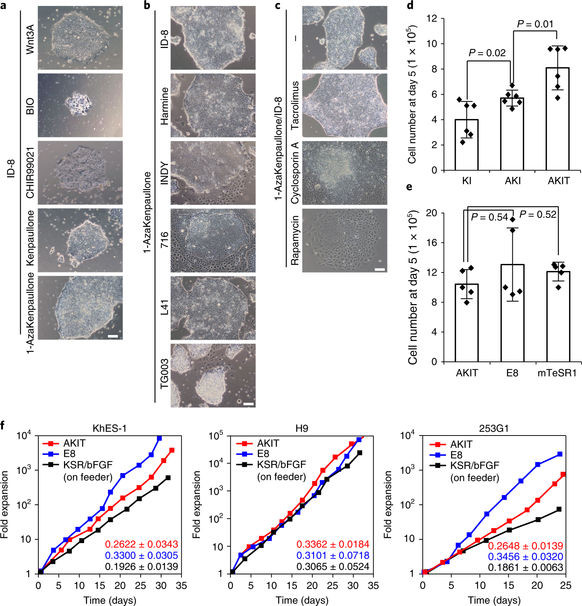ヒト多能性幹細胞の作製と拡大培養用の成長因子を含まない合成培養システム
Chemically defined and growth-factor-free culture system for the expansion and derivation of human pluripotent stem cells
2018年3月5日 Nature Biomedical Engineering 2 : 173 doi: 10.1038/s41551-018-0200-7

品質が管理された細胞療法用および創薬用のヒト多能性幹細胞(hPSC)を大規模かつ経済的に製造するには、理想的には、生物由来成分を含まない合成培養システムが必要となる。そのようなシステムを開発するには、基本培地中の添加物としての遺伝子組換えタンパク質に伴うコストを削減する必要がある。本論文では、組換タンパク質である成長因子を含まない培地を紹介する。これに用いられているのは、わずか3種類の低分子化合物、および市販の培地を下回る数の遺伝子組換えタンパク質である。核型、多能性マーカーの発現、および三胚葉由来の細胞型に分化する能力が確認されたことにより、この培地がhPSCの長期増殖を支持することが示された。この培地で増殖したhPSCは、成長因子を含む培地で増殖した細胞ほど解糖経路に依存しなかった。さらに、この培地は、ヒト皮膚繊維芽細胞由来か末梢血単核球由来かを問わず、人工多能性幹細胞の樹立を支持した。今回の知見は、生物由来成分を全く含まないhPSC合成培養システムの開発をさらに促進するものと考える。
Corresponding Author
The large-scale and cost-effective production of quality-controlled human pluripotent stem cells (hPSCs) for use in cell therapy and drug discovery would ideally require a chemically defined xenobiotic-free culture system. Towards the development of such a system, costs associated with the use of recombinant proteins as supplements in basal culture media need to be reduced. Here, we describe a growth-factor-free culture medium that uses just three chemical compounds and a lower number of recombinant proteins than used in commercially available media. We show that the culture medium supports the long-term propagation of hPSCs, as confirmed by karyotype, the expression of pluripotency markers and the capacity to differentiate into cell types derived from the three embryonic germ layers. hPSCs growing in the medium were less dependent on glycolytic pathways than cells grown in medium containing growth factors. Moreover, the medium supported the generation of induced pluripotent stem cells derived from either human dermal fibroblasts or peripheral blood mononuclear cells. Our findings should facilitate the ongoing development of a completely xeno-free, chemically defined, synthetic culture system for hPSCs.

